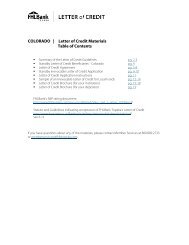BEWARE THE PERFECT STORM - FHLBank Topeka
BEWARE THE PERFECT STORM - FHLBank Topeka
BEWARE THE PERFECT STORM - FHLBank Topeka
You also want an ePaper? Increase the reach of your titles
YUMPU automatically turns print PDFs into web optimized ePapers that Google loves.
MESSAGE FROM <strong>THE</strong> PRESIDENT<br />
DOING WHAT WE DO BEST: MEETING <strong>THE</strong><br />
LIQUIDITY NEEDS OF HOUSING INVESTORS<br />
MESSAGE FROM <strong>THE</strong> PRESIDENT<br />
Andy Jetter<br />
President and CEO<br />
<strong>FHLBank</strong> <strong>Topeka</strong><br />
A severe lack of confidence in the fixedincome<br />
markets causes many housing lenders<br />
to pull back. Typical channels for raising<br />
funds for home financing are blocked.<br />
Funds, if available at all, are at much higher<br />
rates. People trying to finance homes are<br />
facing significant hurdles.<br />
Sound familiar No, I’m not talking about<br />
the recent liquidity crisis. I’m describing the<br />
state of the economy in the early 1930s<br />
that led President Hoover to propose a<br />
system of 12 Federal Home Loan Banks<br />
dedicated to providing liquidity to housing<br />
lenders. President Hoover and the Congress<br />
recognized the importance of ensuring a<br />
stable supply of funds for housing lenders.<br />
Because the need for liquidity would change<br />
depending on the markets, the <strong>FHLBank</strong>s<br />
needed to expand and contract easily.<br />
Therefore, the <strong>FHLBank</strong>s were created as<br />
cooperatives whose capital would adjust<br />
in proportion to the demand for liquidity<br />
by housing lenders. When liquidity needs<br />
were large, the <strong>FHLBank</strong>s grew to meet<br />
those needs. When liquidity needs fell, the<br />
<strong>FHLBank</strong>s dropped in size.<br />
The role taken by the <strong>FHLBank</strong>s in addressing<br />
the liquidity needs of housing lenders<br />
during the recent liquidity crisis was exactly<br />
what was contemplated when the<br />
<strong>THE</strong> FHLBANKS ARE CONSERVATIVE<br />
COLLATERALIZED LENDERS. BECAUSE<br />
OF OUR CONSERVATIVE PRACTICES, NO<br />
FEDERAL HOME LOAN BANK HAS EVER<br />
HAD A CREDIT LOSS ON AN ADVANCE.<br />
THAT INCLUDES A PERIOD OF MARKET<br />
DISRUPTION IN <strong>THE</strong> LATE 80S THAT MAKES<br />
OUR RECENT EXPERIENCE LOOK LIKE A<br />
WALK IN <strong>THE</strong> PARK.<br />
<strong>FHLBank</strong>s were created in 1932. And the<br />
<strong>FHLBank</strong>s met the additional need for<br />
liquidity in a virtually seamless manner, just<br />
as anticipated in 1932. One big difference<br />
between 1932 and today - this time around<br />
the <strong>FHLBank</strong>s supplied needed liquidity<br />
immediately. The suffering in the 30s took<br />
much longer to resolve itself.<br />
But not everyone seems to be in agreement.<br />
I read with some satisfaction a Bloomberg<br />
article published on October 30. The overall<br />
tone of the article was intended to be<br />
critical, but I think most readers probably<br />
reached the opposite conclusion. In brief,<br />
the article noted that the foremost housing<br />
lenders in the country turned to the<br />
<strong>FHLBank</strong>s for liquidity when the normal<br />
channels of housing finance dried up. A<br />
quote from the article is an excellent case<br />
in point:<br />
“The cost of asset-backed commercial paper,<br />
when it was available, shot up. The home<br />
loan banks were the only game in town for<br />
a lot of borrowers. Even AAA-rated credits<br />
were having a tough time issuing paper. It<br />
took everyone back to the Federal Home<br />
Loan Banks.”<br />
The article raised concerns about the risk of<br />
growth in <strong>FHLBank</strong> borrowings needed to<br />
close the liquidity hole. I don’t share the concern.<br />
The <strong>FHLBank</strong>s are conservative, collateralized<br />
lenders. Because of our conservative<br />
practices, no Federal Home Loan Bank has<br />
ever had a credit loss on an advance. That<br />
includes a period of market disruption in the<br />
late 80s that makes our recent experience<br />
look like a walk in the park.<br />
I’m proud to be a part of the <strong>FHLBank</strong><br />
System as we continue doing what we do<br />
best: providing liquidity to housing lenders<br />
to ensure that the supply of funds for residential<br />
mortgage lending is not disrupted.<br />
Sincerely,<br />
President and CEO<br />
2<br />
<strong>FHLBank</strong> Focus | Winter 2007










